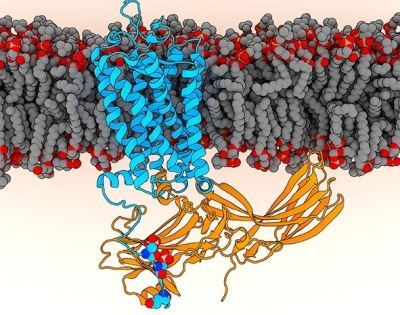Introduction of GPR3
GPR3 is encoded by the GPR3 gene. It belongs to the G-protein-coupled receptor (GPCR) family which is one of the largest and most studied families of proteins because its members are involved in an extraordinary number of physiological functions. It is cloned and sequenced in the mid-1990s along with GPR6 originally. Even though sphingosine-1-phosphate (S-1-P) and Gs protein can active and couple to GPR3 constitutively, the natural ligand of GPR3 is still controversial. It is still one of orphan G protein-coupled receptors.
| Basic Information of GPR3 | |
| Protein Name | G-protein coupled receptor 3 |
| Gene Name | GPR3 |
| Aliases | ACCA orphan receptor, ACCA |
| Organism | Homo sapiens (Human) |
| UniProt ID | P46089 |
| Transmembrane Times | 7 |
| Length (aa) | 330 |
| Sequence | MMWGAGSPLAWLSAGSGNVNVSSVGPAEGPTGPAAPLPSPKAWDVVLCISGTLVSCENALVVAIIVGTPAFRAPMFLLVGSLAVADLLAGLGLVLHFAAVFCIGSAEMSLVLVGVLAMAFTASIGSLLAITVDRYLSLYNALTYYSETTVTRTYVMLALVWGGALGLGLLPVLAWNCLDGLTTCGVVYPLSKNHLVVLAIAFFMVFGIMLQLYAQICRIVCRHAQQIALQRHLLPASHYVATRKGIATLAVVLGAFAACWLPFTVYCLLGDAHSPPLYTYLTLLPATYNSMINPIIYAFRNQDVQKVLWAVCCCCSSSKIPFRSRSPSDV |
Function of GPR3 Membrane Protein
GPR3 expresses in the central nervous system mainly, suggesting that GPR3 may be involved in regulating the health and disease of the brain. GPR3 is implicated in the early phases of cocaine reinforcement, resulting in altering emotional behaviors. Meanwhile, GPR3 has been reported to participate in the development of neuropathic pain, so that GPR3 can regulate morphine-induced antinociception. As to the expression pattern of GRP3 in the central nervous system, GPR3 may play roles in Alzheimer’s disease. According to the hypothesis, GPR3 promotes the production of amyloid-β, which is the main component of amyloid plaques in Alzheimer patients’ brains and are important in Alzheimer's disease. Regarding the possible endogenous ligands of GPR3, some studies report that the sphingosine-1-phosphate (S-1-P) and Gs protein are agonists for both GPR3 and GPR6 because S-1-P and Gs protein can induce cAMP production and Ca2+ mobilization in the GPR3 or GPR6 expressing cells. However, the conclusion of S-1-P or Gs protein as endogenous ligands for GPR3 and GRP6 is challenged by other research groups because they cannot repeat the same experimental results. GPR3 is still considered orphan GPCRs without specific ligand because of the controversy.
 Fig.1 Structure of GPR3 membrane protein. (Zhou, 2017)
Fig.1 Structure of GPR3 membrane protein. (Zhou, 2017)
Application of GPR3 Membrane Protein in Literature
This article demonstrates that cannabidiol can act as a novel agonist for both GPR3 and GPR6, suggesting the potential therapeutic effects of cannabidiol in Alzheimer's disease and Parkinson's disease.
Authors in this group apply to denaturing high-performance liquid chromatography and DNA sequencing to detect the GPR3 sequence variants in 82 predominantly North American Caucasian women with premature ovarian failure (POF), suggesting that the mutations of GPR3 are not a common explanation for POF in this population.
This article reveals that oocytes from GPR3 double knock out mice have significantly lower CDK1 levels than WT mice at the same stage of follicle development, suggesting GPR3 may be involved in regulation meiotic by regulating CDK1 levels.
Authors in this group report firstly a novel GPR3 inverse agonist AF64394, which can inhibit the biological function of GPR3 and it’s structure-activity relationships.
This article demonstrates that GPR3 regulates the amyloidogenic proteolysis of amyloid precursor protein in Alzheimer's disease mice model, suggesting that GPR3 may be a novel drug target for Alzheimer's disease treatment.
GPR3 Preparation Options
To obtain the soluble and functional target protein, the versatile Magic™ membrane protein production platform in Creative Biolabs enables many flexible options, from which you can always find a better match for your particular project. Aided by our versatile Magic™ anti-membrane protein antibody discovery platform, we also provide customized anti-GPR3 antibody development services.
As a forward-looking research institute as well as a leading customer service provider in the field of membrane protein, Creative Biolabs is famous for successfully accomplishing numerous challenging projects including generation of many functional membrane proteins among our worldwide customers. Please feel free to contact us for more detailed information.
Reference
All listed services and products are For Research Use Only. Do Not use in any diagnostic or therapeutic applications.